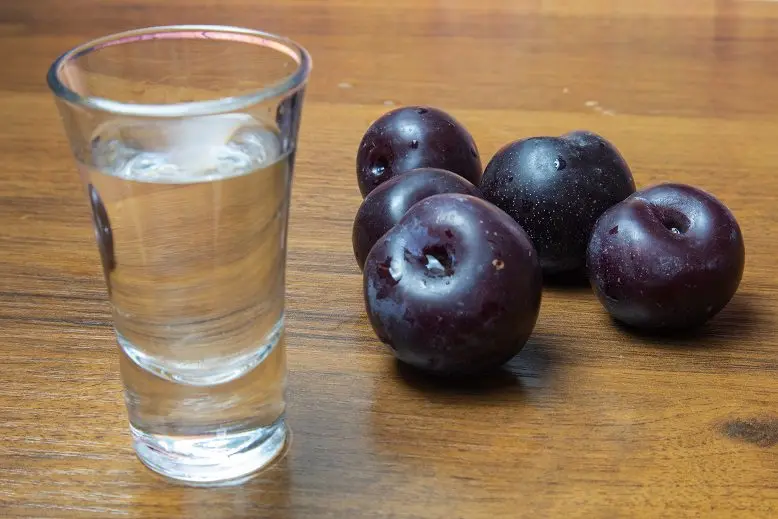Contents
Slivovitz is considered the national alcohol of the Balkan countries (Croatia, Bulgaria, Serbia, Bosnia) and the Czech Republic. There, tourists are treated to this drink, they themselves use it for any reason, and even treat some diseases. Plums grow well in most regions of Russia, so anyone can cook plum brandy at home. I recommend using the classic recipe, because modifications, including the addition of baker’s dry or pressed yeast, turn the uniquely flavored alcohol into ordinary moonshine.
Slivovitsa (Brandy) – This is a strong alcoholic drink (45-75%), belonging to the class of fruit brandies, obtained by double distillation of fermented plum juice, followed by aging in oak barrels. An aging of 5 years is considered optimal, this time is enough for the brandy to acquire a characteristic taste with hints of plums and a yellow color. Homemade slivovitz is rarely aged for more than a year, which is why it is usually transparent or light yellow.
In 2007, Serbia received a European patent for the exclusive production of a drink called “Serbian Rakia Slivovitz” in its geographical region. Rakia, like cognac and champagne, is now protected by EU law. This means that only companies located in Serbia have the right to sell alcohol with this name.
Recipe for plum brandy
In the classic version, apart from drains and water, nothing else is used. But in the rainy season, when the sweetness of the fruit is not high enough, sugar has to be added to maintain fermentation. Remember, the more sugar, the less the resulting drink will look like a classic version, turning into a banal moonshine from plums.
Ingredients:
- plum fruits (any variety is suitable, for example, Hungarian, renklod, altana, egg, mirabelle) – 11 kg;
- clean water – 8 liters (another 4 liters for each kilogram of sugar);
- sugar (undesirable) – depending on the sweetness of the plums.
Technology of preparation
1. Working with fruits
For slivovitz, the sweetest fruits should be selected, even overripe ones, but without rot and mold. Plums should not be washed to remove wild yeast from the peel. Wipe very dirty fruits with a dry cloth.
Remove the seeds, dividing the plums into two halves. Grind the pulp and peel to a state of gruel. This can be done with a meat grinder or a drill with a metal rod at the end.
2. Preparation for fermentation
Taste the wort, the mash should be a little sweet. Otherwise, add sugar. The amount depends on the acidity and sugar content of the plums. Add 100-200 grams of sugar, mix and check the sweetness. Sometimes multiple approaches are required.
Bandage the neck of the container with gruel with gauze to protect against flies and leave for a day in a warm, dark place until fermentation begins. After 24 hours, foam will begin to form on top of the wort, a hiss will be heard, which means that everything is going fine.
Pour the wort into the fermentation tank, add water. After thorough mixing, place a water seal or medical glove with a hole in the finger on top of the container (pierce with a needle). First you need to make young plum wine, and then overtake it for moonshine.
3. Fermentation
Place the container with a water seal in a warm place (18-25°C) and protect from direct sunlight. Fermentation lasts 15-45 days. At this time, the water seal is actively gurgling. When the bubbles stop appearing, the mash will become bitter in taste without sweetness, and there will be a lot of sediment at the bottom, it’s time to move on to the next step.

4. Distillation
Drain the Braga from the sediment, filter through cheesecloth and pour into a distillation cube. It is very important to get rid of the remnants of the pulp that can burn. Overtake the mash for the first time without division into fractions. Finish distillate extraction when the strength in the stream falls below 30%. Moonshine may turn cloudy, this is normal. Measure the strength, determine the amount of pure alcohol.
Dilute the resulting plum moonshine with water up to 20% and overtake a second time. Collect the first 12% of the pure alcohol yield separately. This fraction is called “heads”, due to harmful impurities it can only be used for technical needs. Withdraw the main product until the strength in the stream falls below 45%.
5. Infusion
According to the classic recipe, the resulting drink should be infused in oak barrels (after diluting with water to 45-60%). If there is such an opportunity, I advise you to implement it. Otherwise, after 2-3 days of aging in a dark, cool room in a hermetically sealed container, you can proceed to tasting.

How to drink plum brandy
Due to its high strength, the drink is perfect as an aperitif (alcohol before meals). According to the Balkan tradition, the first glass is not eaten in order to catch all the notes of taste.
Slivovitz drink only in its pure form. When mixed with juices or other drinks, an unpleasant metallic taste appears. Traditionally, slivovitz is served with toasted cornbread, potatoes and meat as an appetizer.









